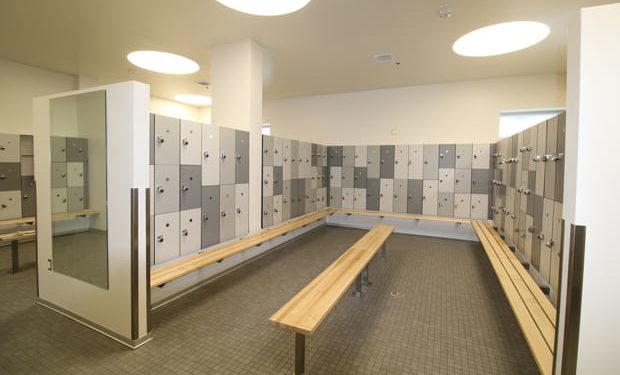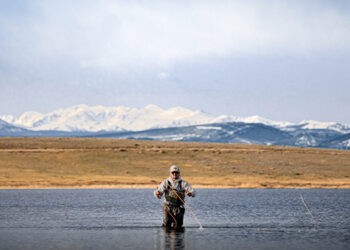When renovating your campus rec center, locker rooms may be the last area you think about. But in keeping up with trends, it should be one of the first. Here, three campus rec professionals discuss the process of locker room renovations and meeting the trending demand of gender inclusivity.
The University of Arizona
The University of Arizona did a complete remodel of their locker rooms from the 1990s, including 14 new gender-neutral cabanas with fully private showers. The call for gender-neutral spaces came from a campus climate survey. It revealed many of the LGBTQ students did not feel safe or comfortable in the campus rec facility due to the outdated locker rooms.
“It is very important our campus community feels welcome and safe in our facility,” said Michele Schwitzky, the senior associate director of campus recreation at the University of Arizona. “This led to conversations with many campus cultural centers and student organizations. The result was moving forward with the locker renovation sooner than we had originally projected.”
With any project of this magnitude, it’s important to collect input from many groups across campus. This must include faculty and staff members. To do this, Schwitzky made sure her department held focus groups to provide this opportunity. Unfortunately, these groups resulted in low attendance and a lack of understanding.
“We had a fair amount of complaints from long-time members after the project was complete who didn’t understand the ‘why’ behind many of our decisions,” she said. “It would have been better if we had communicated with key stakeholders in a more personal way.”
In addition to communication, Schwitzky also offered advice when it comes to choosing products for your locker room renovations. “Research the products to be sure they can withstand the heavy use of a collegiate locker room,” she said. “We installed hotel style hairdryers in the locker rooms and all the cabanas. Within six months they had all died due to the heavy use. We now have hairdryers available for check-out.”
Babson College
Babson College opened their completely renovated Babson Recreation and Athletics Complex in late August 2019, including the accommodation of gender-neutral facilities. Similar to the University of Arizona, Babson College campus rec also did a survey among its student population, faculty and staff to determine the types of amenities they were looking for in the renovation.
“Bathrooms are pretty forward thinking places,” said Mike Lynch, the senior director of athletics and athletics advancement at Babson College. “Our student affairs unit is very aware of the types of kids we have here. We wanted to make sure everyone was accommodated and felt comfortable.”
Some of the changes made included:
- Gender-neutral bathrooms
- Shower facilities
- Locker rooms
- Changing rooms around the shower facilities, in addition to men and women spaces
In reference to lockers themselves, the locker room renovations allowed Babson to offer a variety of multi-use sized lockers from Prozone Athletic for all varsity sport teams and recreational programs. “We also incorporated brand-new locker room areas for our recreational programs, club sports, intramurals, public and campus use. So we have plenty of space for everybody now,” said Lynch.
One aspect of a locker room renovation that is easily overlooked is the opportunity to strengthen the campus brand. “We’re presenting entrepreneurialism and ingenuity in [branding and logos] students will be exposed to when they get here,” said Lynch.
The University of Maryland
Completed in 2017, the University of Maryland (UMD) modified their locker rooms to fit the growing trend of gender inclusivity. Their changes include:
- A gender inclusive locker room in both Eppley Recreation Center (ERC) and Ritchie Coliseum
- A family locker room, single-use and gender-inclusive restroom in ERC
“We worked with our campus LGBTQ office for their recommendations and when we were deciding on partitions for how high or low to go and recommendations for names of the spaces,” said Andrea Bussler, the associate director of facilities at the University of Maryland. “We ran everything through them to get their feedback and spoke with some of the students on campus to find out things they were interested in.”
Some of the feedback Bussler received included having a single-use space or restroom close to a gender inclusive space. Additionally, the LGBTQ office also had a large say in the signage.
“Rather than try to do anything with people, it’s all based on what can you get within the space, so you might put a toilet, a sink or a shower head to represent what’s in that space as opposed to trying to put a person of a male or female,” said Bussler.
Another key aspect to the gender inclusive alterations was selecting the right partitions. UMD worked with ASI Group to install zero sightline doors and overlapping closures for guaranteed privacy. Additionally, they decided on mounting the seven-foot partitions six inches above the floor to provide the best coverage for users and to accommodate safety precautions.
Bonus: Handling Feedback in Locker Room Renovations
One concern during the renovation was where to put the gender inclusive spaces. Bussler received mixed feedback on whether the spaces should be right at the front of the building or in more private areas. “When we actually talked to the students, they said ‘No, we like that it’s discreet,’” she explained.
Due to this feedback, the gender inclusive spaces in Richie Coliseum are in the back of the building. “It’s a balance of finding out what your students and campus are looking for,” said Bussler.
How do you handle possible negative feedback to such a change as gender neutral spaces? Bussler advises communication and offering information. “We have generally just communicated that we are doing this for our college campus, this is what’s appropriate for our campus,” said Bussler.










